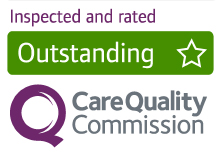Downloaded from www.mymenopausecentre.com
Direct URL: https://www.mymenopausecentre.com/symptoms/bladder-symptoms/
Menopause and bladder symptoms
Bladder issues include leaking, getting up at night, and passing urine more often. Always seek help, and don't be embarrassed – it's a common symptom.
Explore
Book an appointment
The highly experienced doctors and nurses in our menopause clinic are here to help you. Appointments from £190.
Book An AppointmentIf you would like to learn more about the impact of your symptom(s) complete our free online menopause questionnaire here.
What are bladder symptoms?
Many women start to experience bladder symptoms during the menopause transition, but these aren’t inevitable and do not need to be accepted as the new norm. There are lots of positive things you can do and treatments that can help.
The most common symptoms you might experience are:
- Needing to pass urine more often during the day and night
- Pain when going to the loo
- Urgency, so that when you need to go to the loo, you’ve really got to go
- Incontinence, which can be distressing and embarrassing. Leaking becomes more common as we get older, especially if you’ve had children. There are two common types of leakage, and you may experience both:
- Stress incontinence – leaking when you cough, sneeze, exercise, or laugh. Some women leak urine during sex
- Urge incontinence – when you need to get to the loo urgently but don’t make it in time
What causes bladder symptoms?
Falling oestrogen levels in our bodies play a big part. We need oestrogen for healthy tissue in the bladder, the urethra (drainage tube from the bladder), the vagina and its supports in the pelvis.
The loss of oestrogen during the menopause transition makes the tissue in your bladder more sensitive and delicate. Instead of happily expanding as it fills with urine (like filling a balloon with water), the bladder gets irritated and tries to empty before filling. This can lead to discomfort and pain.
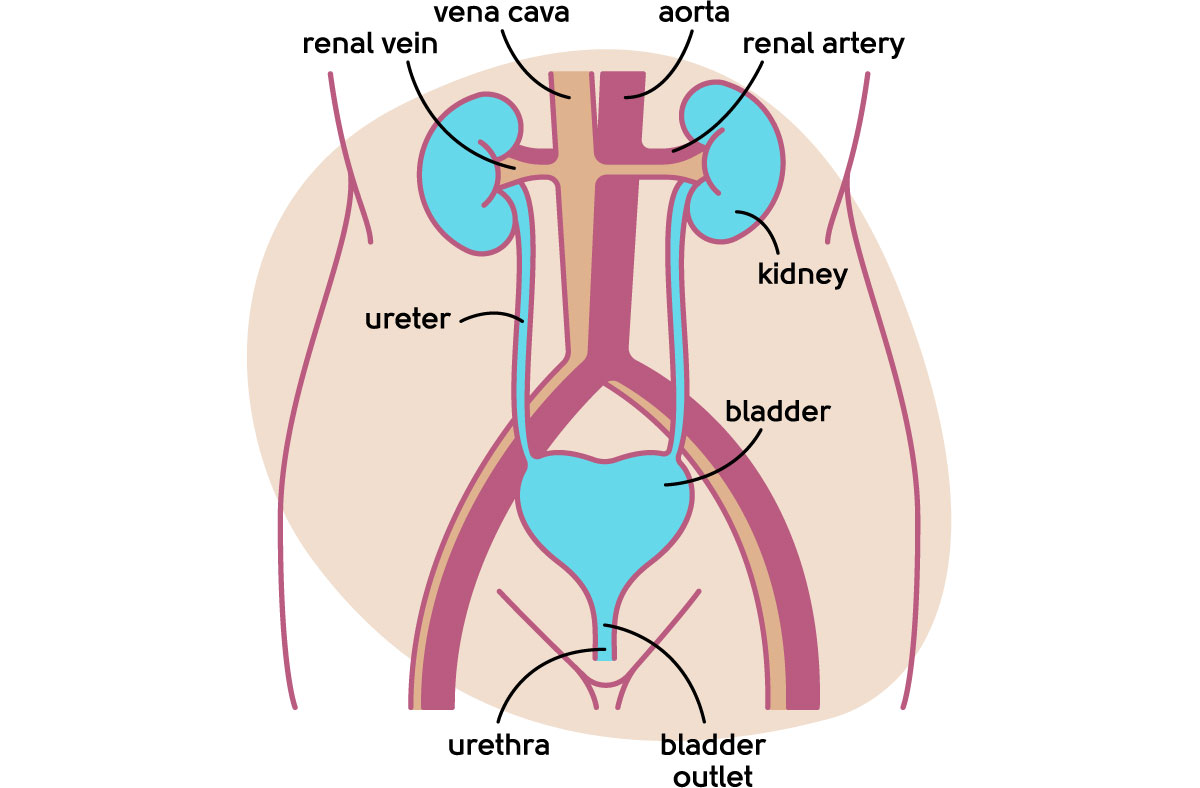
Understanding the anatomy of your urinary tract
As well as the bladder, the urethra and vagina are affected also – this is called urogenital atrophy.
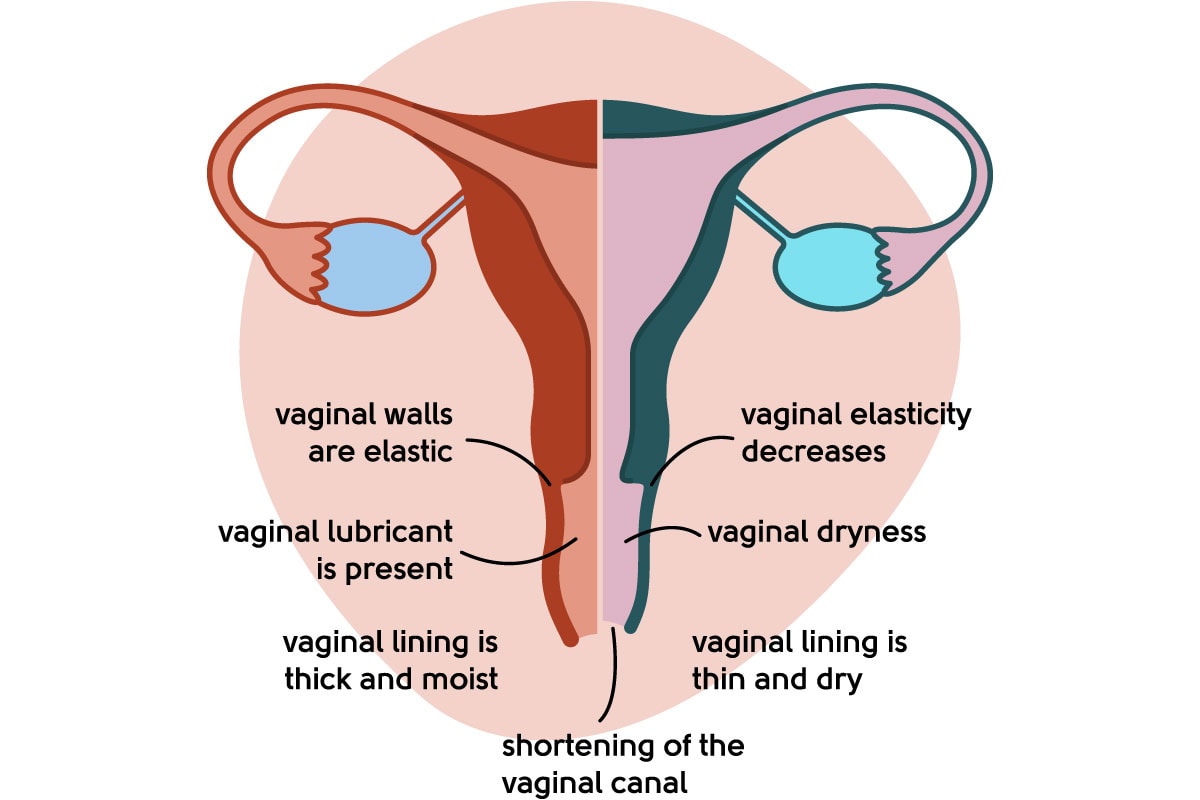
Illustration to show a healthy vagina vs urogenital atrophy
Stress incontinence is caused by weak muscles in the pelvic floor. This can worsen in the perimenopause and menopause, but other important risk factors include childbirth, increasing age and carrying extra weight around.
Any condition that puts extra pressure on the bladder can make stress incontinence worse, including straining to open your bowels (constipation), having a chronic, prolonged cough or being very overweight.
How many women typically experience bladder symptoms?
We can only estimate how many women suffer bladder symptoms during the menopause transition because so many do not report them.
In a study by the British Menopause Society, around a third of women interviewed (aged 45-65) reported symptoms in the bladder related to the menopause[1].
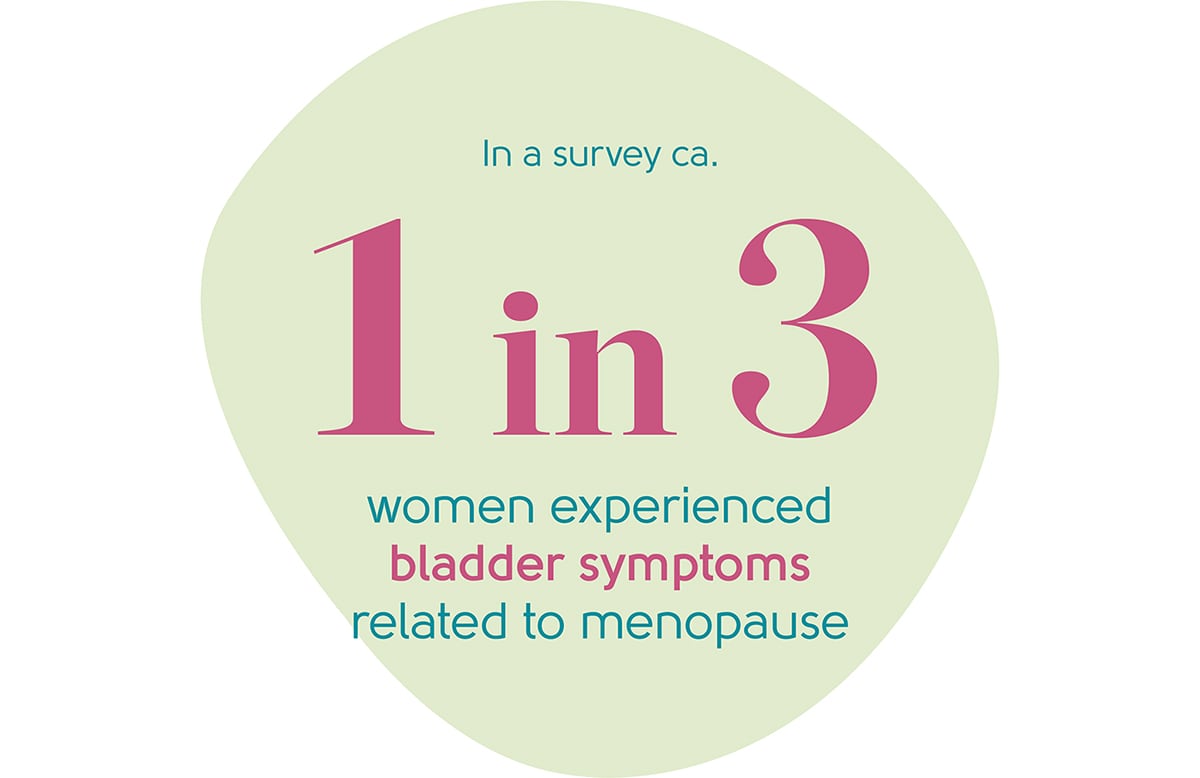
Other studies have estimated that up to two-thirds of women in their mid-70s experience symptoms in the vagina and bladder related to loss of oestrogen[2].
Are bladder symptoms linked to any particular stage of the menopause?
Bladder symptoms become more likely as you get older, as the effects of lack of oestrogen on the bladder take their toll. It’s less likely that you’ll start to experience bladder symptoms in the perimenopause.
The perimenopause typically starts in the mid-to-late 40s (but for some it can be earlier or later) and the average age of the menopause in the UK is 51 years. You can read more about the stages of the menopause here.
How can bladder symptoms be treated?
There are several things you can do to help with your bladder symptoms:
Talk to a doctor
It’s important to remember that you’re not alone. Speaking to a healthcare professional may help reassure you. They can check your urine for infection, and your blood and glucose to rule out other conditions that can cause bladder symptoms.
It’s important to speak to a doctor about new bladder symptoms, particularly if you see blood in your urine, if you’re passing urine frequently with increased thirst, if you have unintentional weight loss, if you have pain when passing urine or if you have pain in your abdomen or back.
Pelvic floor exercises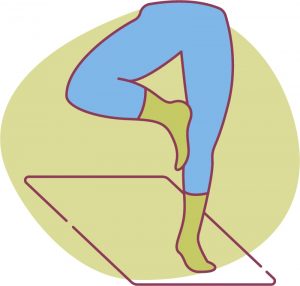
Do your pelvic floor exercises like you’re training for a marathon! They can help prevent leaking from getting worse. Physiotherapy, pilates, pelvic floor exercises (or Kegels) all help to strengthen the supports of the bladder. You can also buy pelvic floor gadgets that may help.
Avoid alcohol and caffeine
Both alcohol and caffeine can increase the volume of urine you make, and also make the bladder more irritable. Both these factors increase the frequency with which you need to pass urine. Try switching to herbal or decaffeinated tea and coffee for a while and see if it helps – it often does.
Stay hydrated
You may be tempted to drink less to avoid filling your bladder, but this is never a good idea. It leads to dehydration and, in the long run, the volume your bladder can hold may decrease.
Weight loss
We know it’s easy to say, and harder to action, but losing weight really will take the pressure off your bladder and help with incontinence symptoms. Our partners at Her Spirit can help with exercise plans.
Bladder training
Training can help limit the urgency and frequency of needing to dash to the loo. It just means ‘hanging on’ for a little while before you go. This trains your bladder not to empty so frequently. Bladder training is usually supervised by trained physiotherapists. Your GP should be able to refer you locally.
Hormone Replacement Therapy (HRT)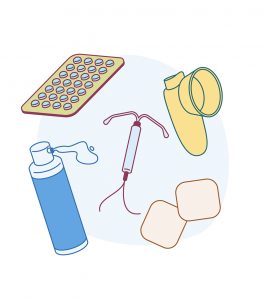
Where bladder symptoms are caused by urogenital atrophy (changes in the tissue of your bladder, urethra and vagina caused by lack of oestrogen), you may be offered HRT. HRT contains oestrogen, which helps improve the bladder and urethral tissues made more delicate by the menopause.
If you have other symptoms of the menopause, systemic HRT (patches, tablets, gels and sprays) can be helpful. If your symptoms are related to the bladder and/or vagina only, you may prefer to use a vaginal oestrogen only.
Around a quarter of women who use systemic HRT need to use a vaginal oestrogen also[3].
You can read more about HRT here.
Vaginal oestrogens
Another way to boost your oestrogen levels in the bladder and vagina is through oestrogen in the form of a cream, pessary or ring, all of which are used directly in the vagina. This type of treatment can be prescribed by your doctor. These types of oestrogens help the bladder and urethra as they lie close in front of the vagina.
‘Vaginal’ or ‘topical’ oestrogens can also help other menopause symptoms like vaginal irritation and dryness, and painful sex. Here are the different types of vaginal oestrogens available:
| Vagifem TM | Tiny pessary of 10mcg oestradiol with single use applicator for each pessary. |
| Vagirux TM | Tiny pessary of 10mcg oestradiol with 1 applicator for re-use. |
| Gina TM | Tiny pessary of 10mcg oestradiol with single use applicator for each pessary – available to buy over the counter for women who meet set criteria. |
| Imvaggis TM | Small pessary of 0.03mg oestriol. No applicator – you insert it yourself into the vagina. Melts, which some women find moisturising. |
| Ovestin cream (Estriol 0.1%) TM | Cream containing oestriol 1mg/g. Comes with a washable applicator, but you could measure out the applicator dose and use your finger instead. |
| Estriol 0.01% cream | Cream containing 0.01% oestriol. Comes with a washable applicator, but you could measure out the applicator dose and use your finger instead. |
| Blissel TM | Gel containing 50mcg/g oestriol. The lowest dose of vaginal oestrogen. This comes with an applicator. |
| Estring TM | A flexible ring that delivers 7.5mcg oestradiol per 24 hours that is fitted into the vagina, releasing oestrogen for three months. You can still continue to have sex with this fitted. |
Gina
Gina is essentially the same as Vagifem and Vagirux – 10mcg oestradiol pessaries with an applicator to help insert them. There are more restrictions in place to buying Gina over the counter than there are to getting the same medication on prescription from your doctor. Gina is available to buy to help manage vaginal symptoms of dryness, soreness, itching, burning and painful intercourse if:
- you are 50 years or older
- your period stopped more than 1 year ago
If you are already taking systemic HRT (for example HRT in patches, gel, spray or tablet form), the pharmacy can only sell you Gina if you have already been prescribed it by your doctor or if your doctor has confirmed that you are suitable to use an additional vaginal oestrogen.
If you are under 50, still having periods or it is less than a year since your last period, or if you are taking HRT, it is likely that you will still be able to use a vaginal oestrogen, but you would need to talk to your GP about your symptoms to obtain this on prescription.
You can find more information on Gina here.
Things to know about vaginal oestrogens
- Treatments may take at least three months to work. If your symptoms don’t improve, always speak to a doctor.
- Vaginal oestrogens don’t affect your risk of breast cancer. The amount of hormone you absorb is tiny.
- There is no risk of blood clots, stroke or heart disease.
- You can use a vaginal oestrogen for as long as you need, but you should have a yearly review by your doctor.
- When you stop using the treatment, your symptoms may gradually return and you may need to restart using it again.
- You may get more vaginal discharge when using a vaginal oestrogen.
What next?
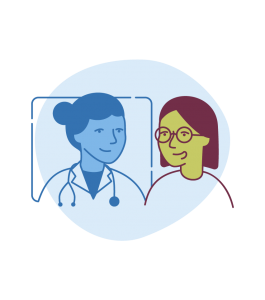
If you’re worried about bladder symptoms, you should see your GP. To talk about your bladder symptoms in the context of the menopause, book an appointment with our menopause clinic.
If you think you may be experiencing symptoms of the menopause transition, you can learn more with our symptom checker or by taking our Menopause Questionnaire.
You can also find more information about the menopause transition at the British Menopause Society and the National Institute for Health and Care Excellence.
Authored by:
Dr Clare Spencer
Registered menopause specialist, GP and co-founder; see Dr Clare in person at The Spire Hospital, Leeds or online
Last updated:
21/12/2022
Book an appointment
The highly experienced doctors and nurses in our menopause clinic are here to help you. Appointments from £190.
Book An AppointmentLearn more
Join the pause. community
We’ve created pause. as a space for women to come together and share stories about their menopause experience, ask questions, and to find support and inspiration. We'll also share the latest news and updates on the menopause from our experts.
Want to be the first to hear our latest news? Join our pause. community today.
Share your email to receive the latest news, updates and information on new products and treatments from My Menopause Centre and our pause. community. You can unsubscribe at any time.
We're committed to protecting and respecting your privacy - see our Privacy Policy and Terms and Conditions

Book a consultation
Whether you want to discuss your symptoms, create a treatment plan that's right for you, understand some test results or have a check-up, the highly experienced doctors and nurses in our menopause clinic are here to help you.
Book nowReferences
-
Source: source: Currie H, Moger SJ. Menopause – Understanding the impact on women and their partners. Post Reprod Health. 2019 Dec;25(4):183-190.
-
Source: Samsioe G, Jansson I, Mellström D, et al. Occurrence, nature and treatment of urinary incontinence in a 70-year-old female population. Maturitas. 1985 Nov;7(4):335-42.
-
Source: Palacios S. Managing urogenital atrophy. Maturitas. 2009 Aug 20;63(4):315-8.
Contact My Menopause Centre
- General enquiries: hello@mymenopausecentre.com
- Book appointments online: Log into your account and go to 'My appointments'
- Book appointments by phone: 0333 444 1067
- Website: https://www.mymenopausecentre.com


















